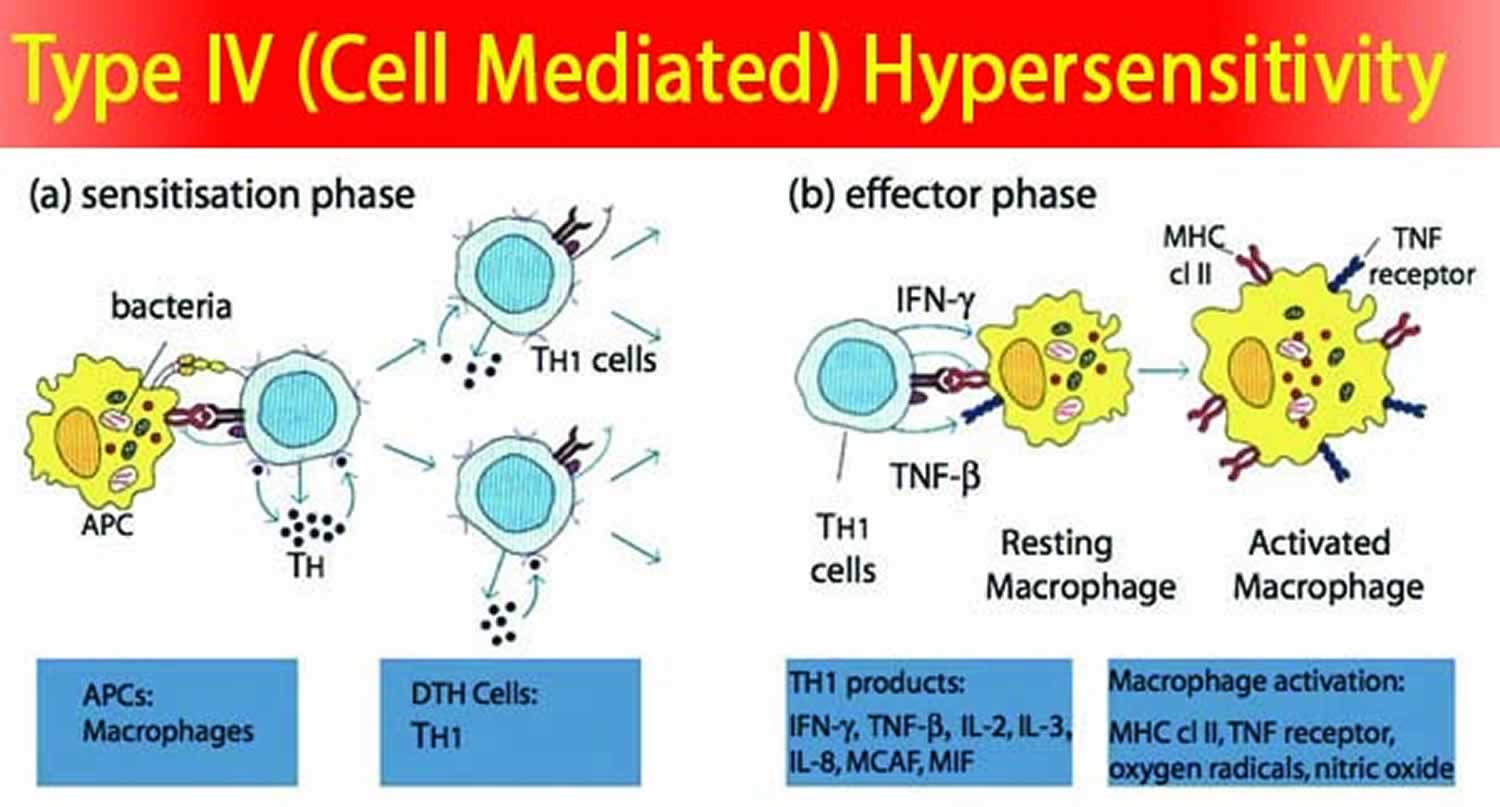Coombs and Gel classified type IV hypersensitivity reaction HR as a delayed hypersensitivity reaction DHR which takes more than 12 hours to develop. DTH Delayed-Type Hypersensitivity response begins with an initial sensitization by antigen followed by a period of at least 1 to 2 weeks.

Delayed Hypersensitivity Reaction Causes Symptoms Diagnosis Treatment
Typically the maximal reaction time occurs between 48 to 72 hours.

What is a delayed hypersensitivity reaction. Mediate Hypersensitivity Allergy. During this phase antigen-specific T cells activate and clonally expand. What is sterilization 2 types of sterilization 1.
Examples of DTH reactions are contact dermatitis eg poison ivy rash tuberculin skin test reactions granulomatous inflammation eg sarcoidosis Crohn disease allograft rejection graft versus host disease and autoimmune hypersensitivity reactions. Antibodies do not mediate DHR. Delayed or late-phase allergic reactions.
The term delayed is used to differentiate a secondary cellular response which appears 48-72 hours. It is mediated by T cells that cause an inflammatory reaction to either exogenous or autoantigens. Delayed hypersensitivity reaction also called type 4 hypersensitivity reaction or cell-mediated hypersensitivity reaction is inflammatory reaction initiated by T cells T-lymphocytes and antigen-presenting cells such as macrophages and dendritic cells that cause an inflammatory reaction to either exogenous or autoantigens which takes more than 12 hours to develop 1.
Delayed hypersensitivity deals with negative reactions to foods chemicals molds more two to three days after consumption. Delayed hypersensitivity reactions are inflammatory reactions initiated by mononuclear leukocytes. The Topic is.
They also play a principal role in tumor immunity and transplant rejection. TH1 subtypes CD4 cells activate during the sensitization phase. In this the allergen introduced into the body and specific IgE is produced which binds to mast cells and basophils.
Submit to safeAssign to avoid plagiarism. Hypersensitivity concept Elaborate over Immediate and delayed hypersensitivity reaction and Anaphylaxis. Elaborate over the clinical scenario of allergy reaction autoimmune reaction and all immunity reaction.
It is referred to as a delayed response in that it will usually require 1224 hours at a minimum for signs of inflammation to occur locally. Delayed hypersensitivity DH delayed type hypersensitivity DTH the type of hypersensitivity exemplified by the tuberculin reaction which as opposed to immediate hypersensitivity takes 12 to 48 hours to develop and which can be transferred by lymphocytes but not by serum. Delayed hypersensitivity plays a crucial role in our bodys ability to fight various intracellular pathogens such as mycobacteria and fungi.
Explain each of the immune mechanism from Type I to Type IV. Contact hypersensitivity and. Delayed hypersensitivity is a common immune response that occurs through direct action of sensitized T cells when stimulated by contact with antigen.
Hypersensitivity reactions are exaggerated or inappropriate immunologic responses occuring in response to an antigen or allergen. A type IV hypersensitivity reaction is also called a delayed hypersensitivity reaction because of its delayed appearance ie after 2448 h following challenge in a sensitized individual. These symptoms can cause massive digestive issues autoimmune diseases migraines and moreIdentifying the rectants that cause these symptoms is.
This is the classical immediate hypersensitivity reaction. Delayed hypersensitivity DH delayed type hypersensitivity DTH the type of hypersensitivity exemplified by the tuberculin reaction which as opposed to immediate hypersensitivity takes 12 to 48 hours to develop and which can be transferred by lymphocytes but not by serum. DTH reactions are of two types.
Atopy is a condition. Type I II and III hypersensitivity reactions are known as immediate hypersensitivity reactions because they occur within 24. How long can a delayed allergic reaction be.
Delayed hypersensitivity can be induced by most viral infections many bacterial infections all mycotic. Delayed-type Hypersensitivity DTH is a subtype of Type IV Hypersensitivity which is induced in response to certain environmental or microbial antigens. Since patients with acquired immunodeficiency syndrome AIDS have a progressive decline in the number of CD4 cells they also have a defective type four hypersensitivity reaction.
-
Do you have bruises or blood spots under the skin. Optimal treatment for this redness includes careful sun protection and skincare. 10 Typ...
-
Try to refrain from scratching or rubbing the affected area. The medical term for hives is urticaria and it describes a condition that produ...
-
While typically mild in children fifth disease. Occasionally red bumps on your legs are the sign of a more serious condition. Red Spots On...
cattle teeth
Cows 101: Do Cows Have Teeth? (Video) Clover. . Cows have three types of teeth: incisors, premolars and molars. Cows can’t bite becaus...

